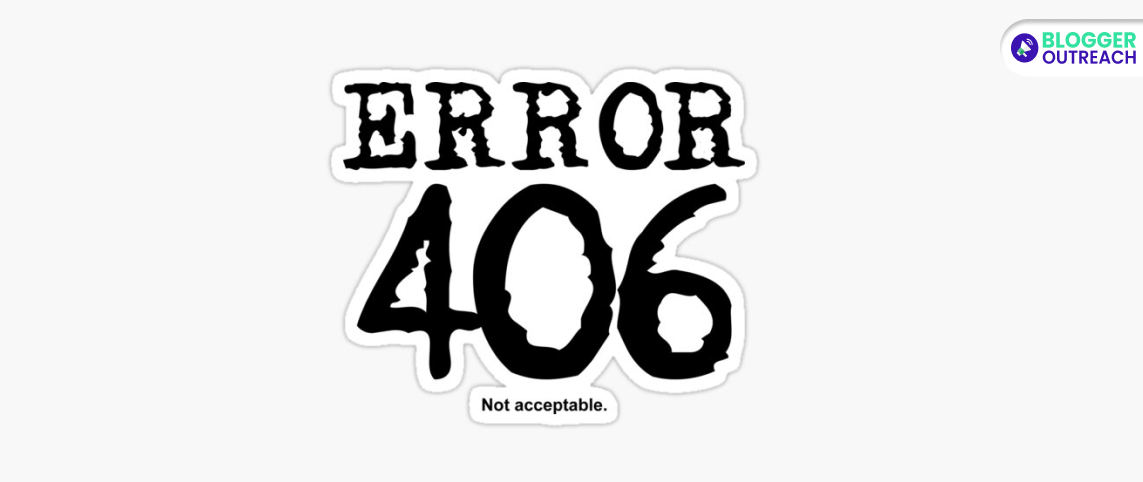Table Of Content
Often overlooked, 406 Not Acceptable Status Code can impact your website’s visibility on search engines.
Basically, a 406 Not Acceptable status code indicates that the server cannot produce a response that matches the client’s request. It’s like you ordered cheese pasta; however, the waiter served you chilli garlic pasta.
This Situation leads to 406 not acceptable errors. This could be due to a lack of available content types or the server’s inability to serve the requested content type.
And this is what this error looks like:

Now, the question is, how does this situation impact your SEO efforts?
Okay, let’s figure it out.
Understanding 406 Not Acceptable (SEO Perspective)
As already mentioned above, the 406 Not Acceptable status code means that the website can’t provide content that matches what was requested. This happens when the accept headers sent in the request don’t match the content characteristics of the website.
This means the server cannot provide the resources the user’s web browser requests.
OR…
The resource is not compatible with the settings specified in the user’s browser.
Causes Of 406 Errors
A 406 error, also known as a “Not Acceptable” error, occurs when a web server is unable to fulfil a request because it cannot provide a response that matches the specific requirements set by the client in its request.
Here are some common reasons why you might encounter a 406 error:
- Mismatched content type: The client (like your web browser) might have requested a specific format for the response, such as JSON or HTML. However, the server is unable to provide the content in that format. This can happen if the server doesn’t support the requested format or if the resource itself doesn’t exist in that format.
- Incorrect language preference: The client might have specified a preferred language in its request. But the server doesn’t have the content available in that language.
- Unsupported encoding: The client might have requested a specific way to encode the data (compressed) for faster transmission. But the server doesn’t support that particular encoding method.
- Issues with the Accept header: The client sends a request with an “Accept” header specifying its preferences for the response format, language, or encoding. If this header has an error, the server might respond with a 406 error.
Deconstructing The Effect On SEO
406 Not Acceptable errors have two effects on SEO.
On one hand, it signifies that the server is functional and the URL exists, both essential components for crawl ability and indexing.
On the other, it restrains access to the content, which could result in incorrect or incomplete indexing by search engines.
An error on your website can stop search engines from accessing it, hurting your rankings. In fact, they can cause your site to be removed from search results entirely.
Identifying 406 Errors For SEO Success
First thing first: SEO specialists and webmasters must take 406 errors seriously and tackle them with the same effort they put into other common SEO issues.
Fortunately, the task is not impossible, and with the right approach, one can rectify these errors and regain the trust of search engines.
(i) Diagnostic Procedures
First, the starting point is identifying the presence of 406 errors on your website. Google Search Console can help you to pinpoint these issues.
Remember, the presence of 406 errors should trigger a thorough investigation of the affected URLs and the underlying server configurations. Webmasters should look at the request headers, server logs, and most common user agents to understand the originating cause.
The next step is fixing the identified 406 errors.
So, How Do You Fix 406 Status Code Errors?
Well, let’s understand this one by one.
- Start with adjusting the server configuration. This can involve examining and adjusting server configurations to ensure the necessary content formats (supported and available). To provide the expected results, please check the server logs and configuration.
- Additionally, addressing the accept headers and the content negotiation process is essential. (Accept headers indicate what media format the client expects from the server.) So, check the accept header and update it so that it matches the client’s expectations.
- Finally, incorporate additional parameters. To get the response in the desired format, the server can modify the request by adding more details based on the specific use case. In some APIs, clients can request the response format by specifying it in the URL.
Did you do the above steps? Still not resolved? Here is what you need to do now:
Reach out to the server administrator. It may be an issue related to the server where the server administrator needs to make changes to the configuration. Maybe they need to modify the API as well.
Here’s How To Avoid Repetitions And Improve SEO
With the knowledge of detecting and resolving 406 Not Acceptable errors, SEO professionals can focus on preventing their resurgence.
(i) Preventive Measures
Proactive measures can include the use of robust server monitoring tools. In turn, it will alert webmasters to the impending or early stages of a 406 issue.
Additionally, checking frequently accessed and critical content to spot errors before they grow into SEO crises.
Finally, involve developers in content negotiation to avoid conflicts and provide customized solutions for client requests.
(ii) Ongoing Vigilance
SEO is not a one-and-done endeavour.
But rather a continuous process that demands ongoing vigilance.
In the case of 406 errors, webmasters must remain alert to changes that may trigger compatibility issues, such as:
- In website structure
- Server environments
- Compliance requirements.
Bottom Line
It’s important to note that 406 errors are relatively uncommon. Most servers simply ignore the specific requirements in the “Accept” header and deliver the content in their default format (instead of returning an error message). This is because a 406 error code can be confusing for users and doesn’t offer much troubleshooting guidance.
So, SEOs should identify its origins and implications, diagnose its appearance, and skillfully resolve its occurrence.
We have already told you to stay vigilant. So, constantly check for errors in the search console. And if you want any, fix them immediately.
Read Also:








